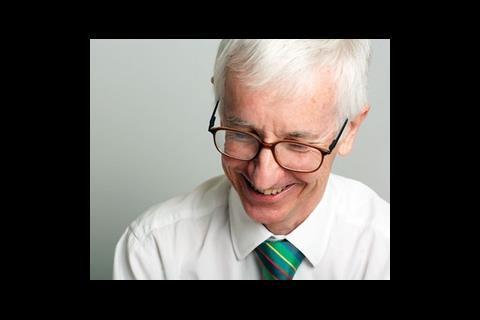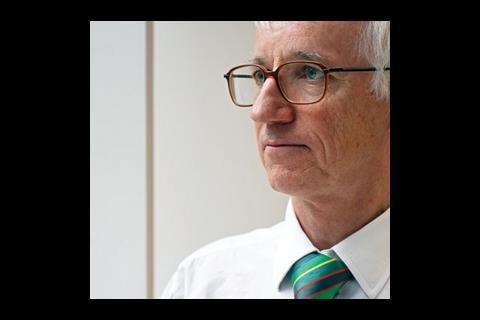One-time Olympic biker Peter Bonfield tells Stephen Kennett why he has more than a sporting chance of doubling BRE’s turnover and pushing sustainability to the fore
There’s not a bead of sweat on Peter Bonfield’s forehead as he calmly scans the newspaper while sitting in reception at Ludgate House, home to BSj. Given that he’s just braved London’s congested roads on the folding bike at his side, that’s quite an achievement. Though not so surprising for someone who, as Bonfield later reveals, was once a national cycling champion and on the Olympic squad.
In fact, it was the new BRE chief executive’s athletic talent that has led to today’s sprint across the capital. Bonfield studied materials science at Bath University and later studied for a doctorate in polymer technology at Loughborough. Both universities had strong sporting credentials which gave him the opportunity to pursue his studies and talent for cycling at the same time. After stints in industry, including the automotive sector and the embryonic wind energy business, he joined BRE. But it was his ties with the Olympic squad and his role training the women’s triathlon team for the Athen’s Games that more recently led to his part-time secondment to the Olympic Delivery Authority (ODA), where he’s been today. “I knew David Higgins [ODA chief executive] in his role at English Partnerships and he was keen I come and support him, partly because of the business I represent but also because of my personal involvement in the Olympics,” Bonfield says.
This led to the 42-year-old working one day a week at the ODA offices where he has been helping draw up the sustainability strategy for the 2012 Games and leading the team working on the construction products that will bring it all to life. It’s a fascinating role, he enthuses, that takes him to a lot of interesting places – the previous evening he met China’s minister for construction to discuss that country’s Olympic brief.
Bonfield has been at BRE for 14 years, and took over as chief executive in March this year. As the UK’s largest testing and research body for the built environment, he also has, if not Olympic, certainly ambitious targets to achieve.
It’s an interesting time in which to take the reins of BRE, which was privatised on the last day of the Conservative government in 1997. Bonfield’s predecessor, Martin Wyatt – now the non-executive chairman – oversaw this major period of change, but Bonfield also played a key role as managing director of BRE’s construction division.
The move from public to private agency wasn’t easy: BRE had strong ties with government and understood the workings of the civil service; its links with the private sector were weak. And in an industry not renowned for investing in research, work had to be hard won. But the switch has gone quite smoothly. Today 45% of the organisation’s work is government-related (which BRE must bid for) while 55% covers commercial projects. The business has grown rapidly, with turnover increasing by more than 25% and profitability up by about 50% in the last year alone, putting it among the top three privately owned research consultancy and testing businesses in the world. Profits are gift-aided to the BRE Trust, a registered charity, which is now the UK’s fifth largest funder of research in construction – it funds a quarter of all the PhD students working in construction.
Bonfield says the decade since privatisation of BRE was a good apprenticeship for his new role. “We’ve had to take a business that was a non-existent commercial venture and pretty well a bust business, if you think about the government funding we had and the civil service culture we had, and help turn it into one that is really vibrant and successful and growing,” he says. But the challenge is far from over. With BRE now established as a successful commercial business, it is Bonfield’s job to step-grow the organisation. The aim is to double turnover in real terms by 2012.
He hasn’t wasted time. Phase one of the plan is already under way. A holding company, headed by Wyatt, has been established to undertake redevelopment of the organisation’s site in Garston, on the outskirts of Watford. The goal is to create exemplary premises that reflect what BRE is about and set an example of what the construction industry can achieve. However, the overriding objective is to release capital from the site, which can then be used to grow the business. Fortunately for BRE, the Garston site is a lot larger than it requires. While another organisation might be tempted to sell the excess land to the highest bidder, BRE plans to redevelop a large chunk of it, creating an ‘enterprise hub’ and surrounding itself with like-minded businesses.
In the last decade we’ve had to take a pretty well bust business and make it a vibrant
Money from the redevelopment - either through sale or rents - will be ploughed back into expanding BRE. Acquisitions will be a key part of this growth plan. Bonfield won’t give too much away, but says they’re looking at some considerable acquisitions that might double BRE’s size. “We’ve got our eye on a few things for the future, some small, some large, but the key thing is the cash release from our site redevelopment to do that.”
He cites the recent acquisition of �ǿմ�ý Performance Group – the London-based practice specialising in the whole-life performance of large building projects such as hospitals – as the sort of success they want to repeat. “It’s been very good for us, they have complementary skills, good data, a good evidence base, a good client base and we’ve grown a whole new business from that,” he says.
The two main touchstones for BRE’s intended growth are the pursuit of sustainability and of innovation. The growing importance of issues such as climate change and the government’s drive for zero carbon homes means that sustainability is now topping the agenda in many companies and Bonfield wants BRE to be ready to capitalise on this. Just a month ago BRE announced it had entered a unique five-year partnership with Marks & Spencer to help deliver its £200 million eco-plan. By 2012 the high-street store aims to become carbon neutral, send no waste to landfill and extend the use of sustainable raw materials.
BRE has been quietly contributing behind the scenes to this strategy and will now help deliver it. “What’s fascinating here is the changing dynamic because here you have a big corporation led by someone [Stuart Rose] who is fully committed to this, not just because he has a personal belief in it but also because he understands it is a prerequisite to future business. In terms of vision and expectation and delivery they are way ahead of environmental NGOs and they have a desire to get on with things now through things such as eco-plans.”
Ten years ago, without any experience of commercial business at the strategic level, BRE wouldn’t have been in a position to take on this kind of work. “People would not think of BRE as that type of company, but actually we can go in and we can work at that level comfortably and understand the company and its priorities,” Bonfield says. “We can then go underneath that and be very flexible in how we support the company to deliver what it needs. What’s different about us is we do it from an evidence base, we have an opinion but most of those opinions are based on fact and experience, so that helps control the risks of getting things wrong.”
But delivering sustainability won’t happen without innovation. “On a global basis, we work by ‘technology hunting’ – we come across great technology and we pour that knowledge back into the UK to the benefit of clients and customers.” This will become increasingly relevant, he believes. Referring to the new Code for Sustainable Homes, which targets water usage, Bonfield talks about washing machines being developed in Japan that will wash clothes with one cup of water – an example of technologies aimed at regions with severe water shortages but which are just as relevant to the UK.
Similar innovations could apply to the healthcare sector. “Do you know what the most important priority for healthcare is?” Bonfield challenges. “It’s not about state-of-the-art hospitals. Healthcare is moving more and more towards the home. The whole process of bringing somebody from home to a hospital is stressful; if you get stressed your immune system suppresses and you’re likely to become more ill. So we want to build homes with the technologies in them that allow people to communicate, be measured, be monitored, be reminded to do things, and that’s not far away.”
Source
�ǿմ�ý Sustainable Design


















